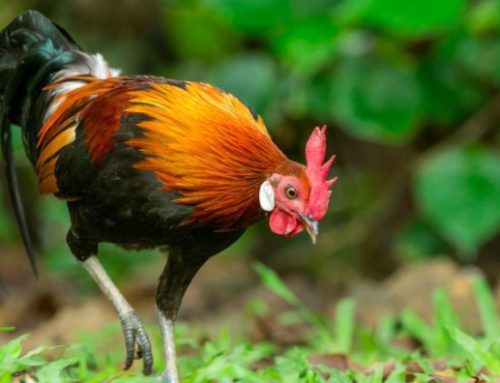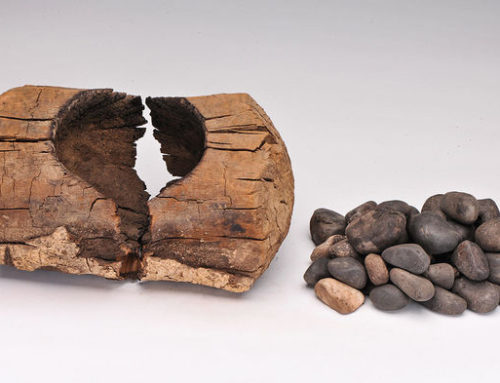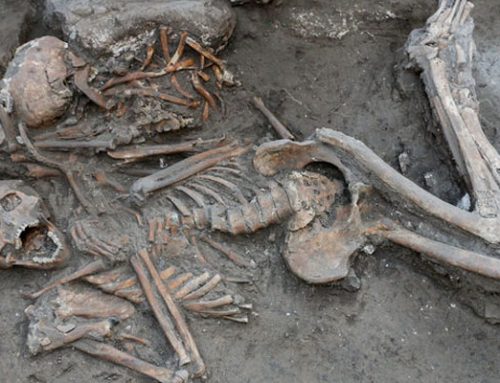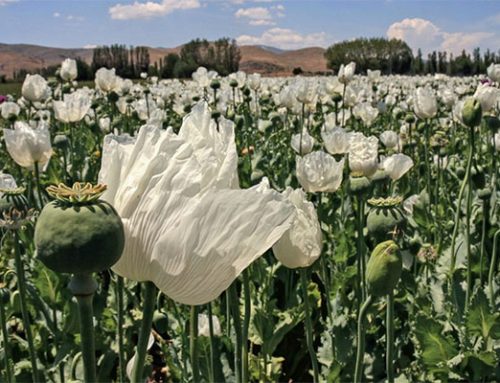ARCHAEOLOGY IN CHINA:
China’s far west, home to unique ancient cultures, may help reveal how technology and goods flowed from West to East to shape Chinese civilization.
Desert death. A 4000-year-old child mummy peers out of his wooden coffin in Xiaohe cemetery on the edge of the Taklamakan Desert.
CREDIT: XINJIANG CULTURAL RELICS AND ARCHAEOLOGY INSTITUTE
YANGHAI, XINJIANG PROVINCE—No place on Earth is farther from an ocean than this dusty spot in the Taklamakan Desert in northwest China. But when archaeologist Lu Enguo recently excavated the sprawling 3000-year-old Yanghai cemetery here, he found a cowrie shell from either the Pacific or the Indian Ocean in the undisturbed tomb of a local shaman. That holy man—his body naturally mummified in the dry climate—was dressed in the style of the Russian steppes, with a headband of gold, a brilliantly colored woven garment, and a ceremonial bronze ax by his side. For him, the wealthy and fertile eastern land called China may have been just a rumor or tall tale.
Yet despite the distance to ancient centers of Chinese culture, Lu, who works for Xinjiang’s archaeology off ice in nearby Turfan, believes that this remote region may hold the key to understanding early Chinese civilization because of its crucial role in trade. Lu and many of his colleagues argue that as far back as the 3rd millennium B.C.E., during the rise of Mesopotamia, Egypt, and the Indus civilizations, Xinjiang may have served as a critical bridge between East and West, funneling some combination of bronzemaking, wheat domestication, and other technologies toward the incipient Chinese culture. Those technologies may have helped jump-start Chinese urban life along the Yellow and Yangtze rivers in the 2nd millennium B.C.E. (see p. 930).
That is a novel, even radical, idea among Chinese academics, many of whom still see Xinjiang as a distant region that enters history only when a unified China began to assert control in the early centuries B.C.E. Indeed, not so long ago, such discussion of outside influence on China’s origins would have been at best frowned upon and at worst dangerous. “Ten years ago, you could not even say that China adopted anything from the West,” says one Chinese archaeologist. After more than a century of humiliation at the hands of foreigners—both Western and Japanese—China’s leaders in the 20th century emphasized the country’s indigenous traditions, and archaeologists followed their direction. Now recent discoveries, coupled with the growing self-confidence of a prosperous nation, are challenging the taboo. “Chinese archaeologists still believe China’s civilization developed independently,” says Wang Wei, director of the Institute of Archaeology in Beijing. “But they also believe that there was important communication with the outside world.”
Before the Silk Road
China’s contact with that outside world may have come from several directions—from Xinjiang in the northwest, from the steppes to the north, overland through Burma and Yunnan to the south, or around Southeast Asia to the eastern coast. The most direct route from the west to east is here in Xinjiang. For centuries starting in the first century B.C.E., the fabled Silk Road stretched across its deserts and mountains, linking the eastern cities of China with European markets. Roman silver, f ine silk, Buddhism, and Islam were passed across its length. Caves filled with Buddhist images, crumbling caravansaries, and ruined cities still dot the province’s dry and rugged landscape.

Forest of graves. These poplar poles from Xiaohe cemetery hint at a wetter climate 4 millennia ago.
CREDIT: XINJIANG CULTURAL RELICS AND ARCHAEOLOGY INSTITUTE
Today, Xinjiang still retains the hallmarks of a crossroads region. Signs in Arabic script and Russian Cyrillic compete with Chinese characters in the province’s capital, Ürümqi, which is closer to Islamabad than it is to Beijing. It is home to ethnic Uighurs—many of whom are Muslim—who traditionally have more in common with their Central Asian brethren than the Han Chinese of the east. Recent ethnic riots in Ürümqi left at least 156 dead and 1000 people injured.
But until the past decade, archaeologists had found little detailed evidence of early human occupation here. Ringed by high mountains, the Taklamakan is one of the world’s driest and hottest deserts. So archaeologists and historians assumed that life here was all but impossible until camels were domesticated and deeper wells and other innovations were developed—long after Chinese cities began to flourish thousands of kilometers to the southeast.
Recent excavations have upended that assumption. In the northeastern edge of the desert, archaeologists from 2002 until 2005 excavated an extraordinary cemetery called Xiaohe, which has been radiocarbon-dated to as early as 2000 B.C.E., says Liu Xuetang, a professor at Ürümqi University and former director of Xinjiang’s archaeology institute in Ürümqi. A vast oval sand hill covering 25 hectares, the site is a forest of 140 standing poles marking the graves of a long-lost society and environment. The poles, wood coffins, and carved wooden statues with pronounced noses come from the poplar forests of a far cooler and wetter climate.

Well-wrapped. One of 30 mummies from Xiaohe buried in airtight ox-hide bags, preserving both skin and cloth.
CREDIT: XINJIANG CULTURAL RELICS AND ARCHAEOLOGY INSTITUTE
A bronze mirror, gold ring, and scatterings of domesticated wheat found in some of the undisturbed tombs show a Central Asian influence. Ox skulls tied to the top of the wooden grave markers show that these animals were sacred. One grave includes a carved wooden snake, the remains of seven real snakes, and a hat made up of small pieces of the ears of sheep, probably serving shamanic purposes common to Central Asia but foreign to eastern China. A tomb of a child holds a pouch with the remains of ephedra, a drug favored by ancient Central Asian pastoralists.
Of 350 tombs, Liu says 190 had been looted and destroyed, but 160 were excavated in the recent digs by a Chinese team. The human remains are eerily well-preserved. Behind the locked doors of the storeroom of the Ürümqi institute, Liu points to a young woman with still-smooth skin and auburn hair, wearing a white wool hat and felt shoes with laces still intact. French and Japanese researchers are helping to analyze the goods and remains at Xiaohe, but that work is still ongoing, he says.
The origins of the Xiaohe culture—which lasted for some 5 centuries, until approximately 1500 B.C.E.—remain obscure. They do not appear to have used pottery, making their connections to other cultures opaque, but there is no evidence that these likely pastoralists were significantly influenced by the Yellow River and other settled cultures to the east. Liu argues that, given their material culture, they probably entered from the north, from present-day Russia, over the Tien Shan mountain range, before 2000 B.C.E. Although no extensive paleoclimate studies have been done, some evidence suggests that the climate became wetter at that time. The poplar no longer found in the area is one sign, as is increased snowfall that created channels through the Tarim Basin that contains the Taklamakan. Some lakebed samples in northwest China hint at a warm and wet period between 2800 and 2000 B.C.E., followed by a 1000-year cold and dry spell, says environmental archaeologist Qi Wuyun of the Institute of Archaeology in Beijing. But she adds that further data are needed.

Shipshape. Some Xiaohe tombs feature boat-shaped wooden coffins unique to the site.
CREDIT: XINJIANG CULTURAL RELICS AND ARCHAEOLOGY INSTITUTE
The most important area of settlement may have been an environmentally hostile region on the desert’s eastern end called Lop Nur, which China used to conduct nuclear tests. But in ancient times, “the Lop Nur delta was a large oasis hundreds of kilometers in length,” Liu says. Preliminary surveys and geological studies suggest a string of settlements along the now-dry Peacock River, which once flowed east and ended in a marshy lake.
Researchers in others parts of Central Asia have found many settlements in similarly marginal climatic zones during the period, such as Gonur in the Kara Kum desert of Turkmenistan. But little archaeological work has been done along the Peacock because of its remoteness, security constraints, and a focus on rescuing sites endangered by development (see p. 936). Increasing aridity by 1500 B.C.E. may have forced the Peacock settlers to revert to a nomadic existence, says Liu. That cycle seems common throughout recorded history in Xinjiang, where small changes in rainfall have a dramatic effect.
Other ancient Xinjiang cemeteries, most from the period starting in 1500 B.C.E., are coming to light and may offer additional clues. At one site in Xiabandi, in the far western end of the province near the Pamir Mountains and adjacent to Kazakhstan, archaeologists found pottery resembling that of the Andronovo pastoralist culture of the steppes. Yet they also found bracelets and earrings that Liu says are in a style common to Gansu, a Chinese province far to the southeast. And to the northwest of Ürümqi, bordering the steppes, Liu excavated a settlement from 1000 B.C.E. with round altars and evidence of horse and sun worship—classic traditions of steppe pastoralists. But at the same site, he also excavated painted pottery of a type found in the upper Yellow River valley. Such finds offer intriguing but still enigmatic evidence of the links between Central Asian pastoralists and China proper, says Liu.
On the bronze trail
The connection between the steppes and eastern China clearly existed. But did pastoralists such as those buried in Xiaohe carry important technologies like bronze eastward? That idea remains controversial. Bronze technologies in the form of weapons and adornment appear starting in the 3rd millennium B.C.E. across the steppes. The Xinjiang bronzes appear to be slightly earlier than several found in Gansu, to the southeast, and then, not long after, in Erlitou in the mid-Yellow River area. That makes for a neat pattern of diffusion. “But the techniques used in Gansu are more developed than in Xinjiang,” notes Liu. And the earliest bronze-casting workshops in the region don’t appear until the 4th century B.C.E., adds Lu. “It is not likely these skills were introduced from Xinjiang,” he says, standing on the parched ground at the Yanghai cemetery.
Trade with Central Asia likely led to the acquisition of bronzes here—but not necessarily the means to make them, Lu says. He and others increasingly think that bronze technology filtered south from Inner Mongolia, far to the east, and eventually was picked up by peoples along the Yellow River.

Heads up. This tiny wooden face provides a glimpse into the beliefs of the Xiaohe people.
CREDIT: XINJIANG CULTURAL RELICS AND ARCHAEOLOGY INSTITUTE
But others point out that mold-casting dominates early Chinese metallurgy, and that technology is not used until later in the region between Europe and Central Asia—arguing against a technology transfer. Some scholars argue there was a connection with the West but that the technology then took an independent turn. Evidence for all theories remains thin. “How does it get to Gansu?” asks Chen Xingcan of the Institute of Archaeology in Beijing. “The route is just not clear.”
Whatever the route for bronze, Lu cites another transformative import that he says arrived from the west via the Peacock River valley: wheat. Domesticated first in the Near East 10,000 years ago, wheat is northern China’s most important staple today. And at the moment, the oldest domesticated wheat in China seems to be that strewn over bodies before burial at Xiaohe 3000 years ago. “The new term we use is the ‘wheat road,’” says Lu.
But other archaeologists in China are not yet convinced. Wheat next turns up in the 1st millennium B.C.E. in northern China, and it’s not clear if wheat from Xiaohe made its way there or if diffusion from the west simply stopped in Xinjiang. “We need to find actual wheat fields at Xiaohe,” says Xiaohong Wu of Peking University. Some researchers instead see a pattern similar to that of bronze, with wheat coming from the steppes through Inner Mongolia. And a recent find of a few early wheat samples roughly dated to 2000 B.C.E. in the far southeastern province of Fujian raise the possibility of seaborne transfer from the Indus civilization in today’s India and Pakistan.
Similar debates revolve around the appearance of domesticated sheep, goats, and cattle in China. Xinjiang sites show evidence of all three in the 2nd millennium B.C.E.—about the time that they appear in central China. But tracing a path of diffusion is difficult, in part because there are few Chinese zooarchaeologists. Everyone agrees that these questions require more extensive excavations in the province as well as better analytical techniques. In a region that retains its position as a continental crossroads, archaeologists are only starting to understand how this bridge between East and West contributed to China’s evolution.
Science 21 August 2009:
Vol. 325. no. 5943, pp. 940 – 943
DOI: 10.1126/science.325_940




